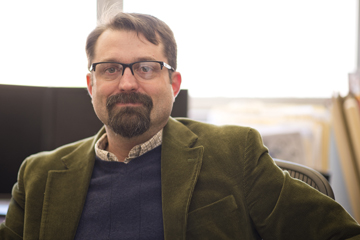Purdue Profiles: Kory Cooper
April 8, 2014
 |
|
Kory Cooper, assistant professor of anthropology. (Purdue University photo/Steven Yang) |
Kory Cooper knows that understanding ancient technology and how it was used can help modern-day engineers gain new perspective on current challenges.
As assistant professor of anthropology with a courtesy appointment in the School of Materials Engineering, Cooper is uniquely positioned to share these insights with his students.
He is co-creator of Archaeology and Materials Science, a 500-level course that combines the examination of artifacts with exploration of social theory surrounding their manufacture and use. On Thursday (April 10), he will participate in a panel discussion about interdisciplinary teaching and research in the College of Liberal Arts at Purdue. The panel is part of a daylong discussion, called "At the Intersection of Liberal Arts and STEM," about how the disciplines are enriched when they intersect.
Could you share more details about the interdisciplinary course you co-created?
Archaeology and Materials Science is a course I created with Carol Handwerker, who is the Reinhardt Schuhmann Jr. Professor of Materials Engineering in the School of Materials Engineering. We offer it every other year, and it's cross-listed in Anthropology and in Materials Engineering.
In the course, students learn about the methods and instruments used to analyze archaeological materials, but they also learn the theoretical approaches used in anthropology to study technology This really helps introduce students to much larger ideas outside of simply learning about the artifacts themselves -- we encourage our students to think about, for example, technological change, where it comes from and how the peoples of the past solved problems innovatively.
What are some examples of artifacts the students study?
Our students look at a variety of materials, including samples of prehistoric and historic metal artifacts from Alaska that have been prepared for metallography. This involves examining microstructures to gain a better understanding of composition and manufacturing processes.
Other materials include lithics and ceramics, both archaeological and the results of recent experiments, including those made in the class.
How can students apply knowledge they gain in this class to their careers in engineering and other disciplines?
It can be a very eye-opening experience for students to learn about ancient technologies and study how they were used and why. Often, learning about how past cultures used technology to solve problems can give students a new perspective on modern-day challenges.
In Archaeology and Materials Science, we try to impress upon our students that people have been doing complicated and sophisticated things for a very long time. We want to teach tomorrow's engineers, for example, that different cultures have approached the same problems from many different angles -- we want the students to realize that there's never one single way to approach a challenge.
At the same time, we want our students to understand that "common sense" when it comes to technological solutions really doesn't exist. Technological solutions are deeply embedded in human culture. It's important that they understand how other cultures from the past have approached challenges.
Why do you think collaboration among liberal arts and science fields is important?
From my experience, that kind of collaboration benefits everyone involved.
Archaeology, for example, is a subfield of anthropology, and it has always relied heavily on other sciences. It's commonplace for archaeologists to collaborate with geologists, chemists, physicists and others, and it's commonplace for archaeologists to develop specialties in the physical sciences. I'm an example of this because I've developed a specialty in metallurgy since my research has focused on native copper innovation.
There are a lot of potential positives for professionals and academics to blur the line between liberal arts and sciences. For example, most problems today cannot be adequately addressed by a single discipline. If we extend the recognition of this limitation to the practice of archaeology, then, to understand the past, we must adopt a holistic approach that's framed around culture, technology and the environment.
This is what makes anthropological archaeology unique -- it’s part social science and part physical, material and natural science. It’s a lot for one person to try to accomplish on their own, even if he or she does become specialized in methods or techniques outside of anthropology. That's why archaeologists have a long history of collaborating across disciplines.
Such collaborations are beneficial to non-archaeological participants because other disciplines lack -- but often find useful -- the time depth available to archaeologists for examining and addressing big questions, including issues related to sustainability and the relationship between culture and technology.
Ultimately, combining liberal arts and the sciences can be incredibly useful. I look forward to exploring that even more here at Purdue.
Writer: Amanda Hamon Kunz, 49-61325, ahamon@purdue.edu
